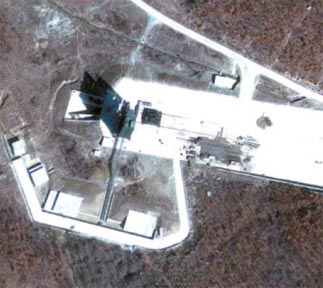North appears close to 2nd launch site for missiles

A satellite image shows a second launch pad for ballistic missiles in North Korea, in Tongchang-ri, being constructed in 2009. [YONHAP]
New satellite images show the North has almost completed a 30-meter-tall (100 feet) launch tower at the Tongchang-ri site near its border with China, reports said.
Tim Brown, the globalsecurity.org image analyst who identified the development, told Voice of America that Pyongyang has been developing the site in the northwest part of the country for about 10 years.
The secretive state is developing what it calls a Taepodong-2, with an estimated range of 6,700 kilometers (4,160 miles), but testing so far suggests it is still a long way off from producing the complete weapon.
The North’s arsenal already includes intermediate-range missiles that can hit targets at up to 3,000 kilometers away, officials say. Those missiles could hit all of Japan and put U.S. military bases in Guam at risk.
Brown said the new launch facility was a more advanced operation than North Korea’s first site, at Musudan-ri, because it has a rocket engine test stand, missile assembly and test buildings, a launch bunker and an observation tower.
“Little by little, they’ve been getting closer and closer to having an operational site. We can now say, I think confidently, that the launch tower and the launch pad are basically finished,” Brown told VOA. “The question is do they have a launch vehicle that’s ready to be launched? And we just don’t know.”
The site is seen as key to Pyongyang’s quest to build a missile capable of delivering a nuclear weapon across the Pacific. Experts say they do not believe the North can miniaturize an atomic weapon to place on a missile, but it is trying to develop such a warhead.
It needs more nuclear testing to build one. North Korea detonated nuclear devices in 2006 and 2009, and conducted long-range missile tests three times - in 1998, 2006 and 2009. The missiles fizzled out shortly after takeoff.
Reuters
Related Korean Article[중앙일보]
“북, 미국 겨눈 ICBM 제2 발사대 완공”
정부·WP 잇따라 확인
북한이 평안북도 철산군 동창리에 건설한 제2미사일 발사기지에서 최근 장거리 탄도미사일을 쏠 수 있는 발사대 공사를 끝낸 것으로 파악됐다. 정부 당국자는 17일 이같이 확인하고 “그러나 현재 북한의 미사일 발사 움직임은 없다”고 말했다. 미국의 워싱턴 포스트도 16일 “최근 촬영된 위성사진에 따르면 높이 100피트(약 30m)의 현대식 발사타워 옆에 커다란 발사대가 설치돼 있는 게 포착됐다”고 전했다.
북한은 2001년 동창리 기지 공사를 시작했으며, 2008년 5월 대륙간탄도미사일(ICBM)용으로 추정되는 로켓 엔진 성능 실험을 실시한 바 있다. 북한은 그동안 함경북도 무수단리 발사기지를 운용해 왔다.
우리 정보 당국은 무수단리 기지가 노후화됐고, 장거리 미사일 발사 때나 유사시 한·미의 공격에 취약하다는 판단에 따라 동창리 기지 건설을 추진한 것으로 보고 있다. 워싱턴 포스트도 동창리가 무수단리보다 미국 정보 당국에 의해 잘 식별되지 않기 때문에 군사적 타격으로부터 상대적으로 안전하다는 전문가들의 분석을 전했다. 군사 전문 사이트인 ‘글로벌시큐리티닷오알지’의 위성사진 판독 전문가인 팀 브라운도 로이터와 인터뷰에서 동창리의 발사대가 무수단리 발사대보다 정교하다고 평가했다. 그는 동창리의 미사일 발사대가 중국의 발사대와 “놀라울 정도로 흡사하다”며 제조 과정에서 중국의 협조가 있었을 개연성을 거론했다.
동창리는 북한의 핵 개발 단지인 영변에서 약 70㎞ 떨어져 있어 북한이 한·미 정보 당국의 감시망을 피해 핵무기 등을 실어 나르기가 무수단리보다 용이하다. 동창리 입지와 관련해 한 국책연구기관 연구위원은 “장거리 발사용 제1미사일 기지인 함경북도 무수단리에서 발사하면 1단 추진체가 일본 근해로 떨어질 수밖에 없지만 동창리에서는 일본을 거치지 않고 태평양으로 쏠 수 있다”고 설명했다. 그는 “동창리에서 일본 오키나와 방향으로 발사하면 1단 추진체가 중국 연안에 낙하한다”며 “하와이 방향이라면 동해상에 1단 추진체가 낙하하고 2, 3단 추진체는 태평양 상공으로 비행한다”고 덧붙였다.
제임스 클래퍼(James Clapper) 미 국가정보국장(DNI)은 16일(현지시간) 북한의 핵무기와 미사일 프로그램이 동아태 지역은 물론 그 이외의 지역까지 심각한 위협이 되고 있다고 밝혔다.
그는 미국 상원 정보위원회에 출석해 “북한은 핵보유국으로서의 국제적 인정을 갈망하고 있으며, 핵 기술들을 판매할 용의까지 보여 왔다”며 이같이 말했다. 클래퍼 국장은 정보위에 제출한 연례안보 위협 보고서에서 북한이 2006년과 2009년 대포동 2호 미사일을 시험 발사한 사실을 거론하며 “북한이 통신위성을 궤도로 진입시키는 목표에는 실패했지만 ICBM과 관련된 많은 기술을 성공적으로 실험했다”고 평가했다.
그는 이어 “만약 ICBM이 만들어지면 대포동 2호는 최소한 미국의 일부에 도달할 수 있을 것이며 미사일과 관련 기술이 수출될 수도 있다”고 우려했다.
http://news.joins.com/article/089/5073089.html?ctg=










with the Korea JoongAng Daily
To write comments, please log in to one of the accounts.
Standards Board Policy (0/250자)